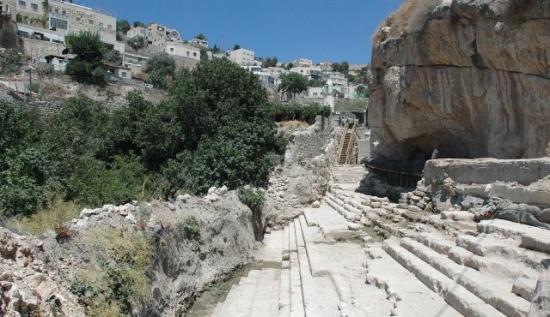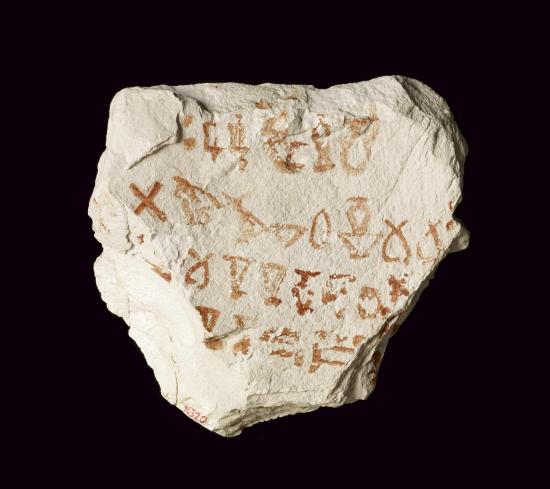How upstart mathematicians and archaeologists are revealing the secrets of letters penned more than 2,500 years ago – and finding clues about when the Bible was written.
Ariel David
Source - http://www.haaretz.com/life/archaeology/.premium-1.652843

Proven remains from the First Temple era are very rare (shown in picture: Pool of Siloam, at the southern slope of the City of David, where First Temple era structures were found).) Photo by Tomer Appelbaum
What do 2,600-year-old administrative documents written on potsherds have to do with computer algorithms? And what can routine supply requisitions and urgent requests for reinforcements from a long-gone army tell us about the origins of the Bible? A maverick team of mathematicians, physicists and archaeologists at Tel Aviv University is on a high-tech quest to answer those questions by unlocking the secrets of the few written documents from the First Temple period that have survived to this day. The new techniques the researchers developed may not only revolutionize the way scholars study ancient inscriptions, but also paint a better picture of the level of sophistication and literacy in the ancient kingdoms of Israel and Judah. Ultimately, their work could help shed light on the tantalizing question of when biblical texts were first put in writing.
Hundreds of years before the Dead Sea Scrolls
The project was started six years ago by archaeologist Israel Finkelstein and physicist Eli Piasetsky, two researchers already adept at enlisting the exact sciences to study the past. Finkelstein is one of the leading voices in biblical archaeology calling for a more scientific approach to the discipline, and tends to be critical of more classical views that, he feels, interpret discoveries in the field to fit and confirm the biblical narrative. From new and more precise dating techniques, to extracting the DNA of ancient peoples from their bones, "archaeology is going through a dramatic revolution in recent years," Finkelstein says.
The two scholars set out to apply modern scientific methods to texts written before the destruction of the First Temple in 586 BCE, hundreds of years before the more famous Dead Sea Scrolls.
In the First Temple period, most documents were probably written on fragile papyrus, and are long gone. But over the last century, at sites across the Holy Land, archaeologists have unearthed at least four large troves of potsherds with writing in the Paleo-Hebrew alphabet used in ancient Judah and Israel. Pieces of broken pottery were easily available throughout the ancient world and were often used in the military or civil bureaucracy: the messages were written on the hard ceramic using ink. Such fragments are also known as ostraca (singular: ostracon), from the name of the pottery shards on which ancient Athenians would inscribe the name of those they voted for to be exiled from the city – hence also the term ostracism.

An example of an ostracon from ancient Egypt, New Kingdom era (550-1307 BCE). Photo by Wikimedia Commons
Unknown text emerges
The largest collection of First Temple ostraca was found in Samaria, the capital of the ancient Kingdom of Israel, and dates to the first half of the 8th century BCE, a few decades before the kingdom was conquered by the Assyrian empire. Three more groupings of potsherds come from Judahite strongholds and date to the late 7th century or early 6th century BCE, at a time when the Babylonians and their allies were starting to encroach on the borders of the Kingdom of Judah.
The first step in the study was to snap digital images of the collections to preserve the text. After the shards are excavated and exposed to the light, the ink deteriorates and fades away, Finkelstein explained.
The project was put in the hands of a trio of thirty-something PhD students in mathematics: Arie Shaus, Shira Faigenbaum-Golovin and Barak Sober. All three left promising careers in the high-tech and defense industries to immerse themselves in the study of First Temple period ostraca.
"It may sound strange, but it feels more significant than what I did before," said Faigenbaum-Golovin, who used to be a programmer for software giant Amdocs. "You feel that you are really making a small but important contribution to human knowledge."
The trio's first challenge was to build a camera that would take multi-spectral images of the ostraca, high quality pictures that capture frequencies of light that are invisible to the human eye, including in the infrared range of the spectrum. Researchers in Jerusalem have been using a similar method to digitize the Dead Sea Scrolls, partly with the support of Google and using state-of-the-art equipment. For the ostraca, the three mathematicians had to get a bit creative.
"We borrowed an expensive camera and discovered a way to reproduce it on the cheap," said Sober, one of the mathematicians. "We cannibalized a Canon camera and created a system that would have cost tens of thousands of dollars for a few thousands."
Still, the jury-rigged system yielded excellent results. Not only did the dark ink on the potsherds appear more clear and readable: in some cases, the images revealed texts that had gone unnoticed.
"Once, the technician mistakenly photographed the reverse side of an ostracon, which was known to be blank, and the image revealed four clear lines of text there," Shaus, the third mathematician on the team said during a tour of their lab. "It had been sitting in a museum for 50 years and nobody ever noticed this."
The last days of Judah
The new text is still being deciphered, but "of course now we are going back to photograph all the ostraca that could have writing on the reverse side," he said.
Using the images, the team also developed algorithms that allow software to recognize the handwritten characters of the Paleo-Hebrew alphabet and produce an automatic facsimile of the text, reducing the chance of scholars mistaking one letter for another.
"Before, epigraphists would manually transcribe inscriptions, which is a subjective, interpretative process," Shaus explained.
The documents themselves, translated by scholars over the past decades, have mostly rather mundane content.
The Samaria ostraca list produce brought into the city from the surrounding countryside.
Many of the potsherds found in the remote Judahite fortress of Arad, in the Negev desert, are addressed to the outpost's quartermaster, Eliashiv, and order him to distribute wine, oil and bread to mercenaries and soldiers stationed in the region.
But some of the ostraca strike a more dramatic tone, and bear witness to the final days of the Kingdom of Judah.
One of the potsherds from Arad, probably sent to one of Eliashiv's superior officers, is a panicked note from the king in Jerusalem with an order "incumbent upon your very life" to send reinforcements to nearby Ramat Negeb to counter a threat from the neighboring Edomites.
We don't know what the response to the message was, but shortly after the order was received, the Edomites, who were allied with the Babylonians, overran the entire area and destroyed the Arad citadel.
Confirming Jeremiah?
Even more gripping is the tale told by perhaps the most known ostracon from the period, which was found in Lachish, the largest Judahite town after Jerusalem. In the dispatch, an official stationed outside the city reports to his commander on the fall of a nearby stronghold, saying that "we can see the signals from Lachish, but we no longer see Azekah."
Scholars have taken this as a confirmation of the biblical narrative of Jeremiah, which recounts that Azekah and Lachish were the last fortresses of Judah to fall before Jerusalem was besieged and destroyed by the Babylonian king Nebuchadnezzar II.

Remains of the ramp built to conquer the Judahite city of Lachish. Photo: Wikimedia Commons
But the most significant part of the Tel Aviv University project goes beyond the content of the ostraca and seeks to learn more about the people who wrote them. This is done by a statistical analysis developed by our indefatigable trio of mathematicians.
For now, the experiment is being run on the Arad letters: it aims to determine how many different hands were behind the letters that reached the small outpost, which housed perhaps 50 soldiers.
The researchers selected 17 out of some 100 ostraca found there and wrote software that compares the handwriting on the most used letters of the alphabet.
"Was there a single scribe who took down all the orders for Eliashiv and the others in the fortress, or were there many people who knew how to read and write? Was writing widespread or was it just a tool for the elites?" wonders Finkelstein.
The results of the analysis are being kept under wraps ahead of publication in a scientific journal. But Finkelstein believes there is sufficient evidence to show that late 7th century Judah was a sophisticated kingdom with a relatively high level of literacy.
"The medium was so spread, that even a humble quartermaster in a small, remote desert outpost used it," Finkelstein said. "There must have been a large education system to support that."
More than just give us a picture of the structure of the late Judahite kingdom, the analysis is a clue that other kinds of literary work could have been going on, Finkelstein noted.
Scholars debate whether biblical texts were first put in writing before the destruction of Jerusalem or after Judahite deportees returned from their exile in Babylon, in the Persian or even the later Hellenistic period.
"The problem is that from 586 until the Hasmonean period we have a very low, almost non-existent amount of Hebrew inscriptions in Judah," Finkelstein told Haaretz. "On the other hand we see this strong literary activity before the exile, in the late monarchic period."
This suggests that at least some parts of the holy text may have been put in writing before the exile, Finkelstein said. He has long supported the theory that an early nucleus of biblical text may have been written down some time after the Assyrian conquest of the kingdom of Israel, around 720 BCE, as the small realm of Judah struggled to absorb the refugees from its once prosperous northern neighbor.
In this context, part of the biblical narrative would have served to combine the different traditions of the two peoples and create a common ground, Finkelstein said: "The aim was to create one entity, one people, one Israel."